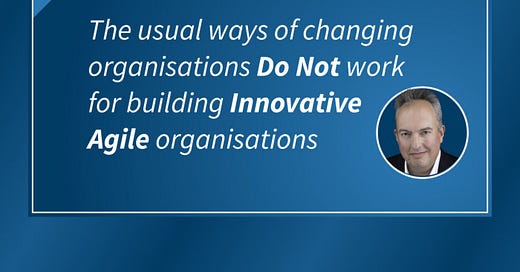Free learning videos (4 of 6)
The fourth in a series of six open-access videos to help you create a future-fit culture
“He that will not apply new remedies must expect new evils; for time is the greatest innovator.” — Sir Francis Bacon (1625) 1
How can you go about creating the kind of future-fit culture of innovation, agility, and adaptiveness your organisation needs if it’s to thrive in an increasingly uncertain and unpredictable world?
This is the fourth in a series of six short, free access videos to help you answer that question in ways that work in your unique organisational circumstances.
In case you missed any of the previous videos you can catch up via the links towards to end of this post.
The videos will be relevant to:
practitioners engaged in catalysing cultural transformation
aspiring future-fit culture catalysts
executives championing, sponsoring, and supporting cultural transformation
Video 4 - The usual change methods don’t work for creating future-fit, innovative, agile organisations (6 mins 4s)
There are four main methods that organisations have traditionally used in their culture change efforts.
Unfortunately, none of these work for creating future-fit cultures.
The video below explains why you’re setting yourself up to fail if you seek to move the needle using one of these methods.
Previous posts in the series
Video 1 of 6 (1 min 33s) addressed the need to encourage diversity of perspectives whilst avoiding organisational fragmentation. It described how diversity of perspectives, thinking, and outlook is the lifeblood of innovation, agility, and adaptiveness. However, this diversity also significantly increases the risk of misunderstandings, mistakes, and missed opportunities. Video 1 described the nature of the challenge, and its general solution. Catch up on Video 1 via the button below:
Video 2 of 6 (3 min 47s) addressed the challenge of overcoming fiefdoms, factions and silos. It described how, over time, different areas in an organisation tend towards entrenched localised perspectives. This encourages fragmentation, which is the number one organisational barrier to innovation, agility, and adaptiveness. Video 2 explored why this happens and how to systemically prevent it. Catch up on Video 2 via the button below:
Video 3 of 6 (5 min 23s) explained how one of the fundamental characteristics of being human is that we each form our own unique, individual perspectives on reality. Each of our perspectives is inherently incomplete, biased, and one-sided — in effect, all we each ever have is a two dimensional — or 2D — take on the bigger picture three dimensional — or 3D — reality. Video 3 laid out why 2D3D mindsets are the essential foundation for creating a future-fit culture of innovation, agility, and adaptiveness.. Catch up on Video 3 via the button below:
From essay, Of Innovations (1625). As collected and translated in The Works of Francis Bacon (1765), Vol. 1, 479.




